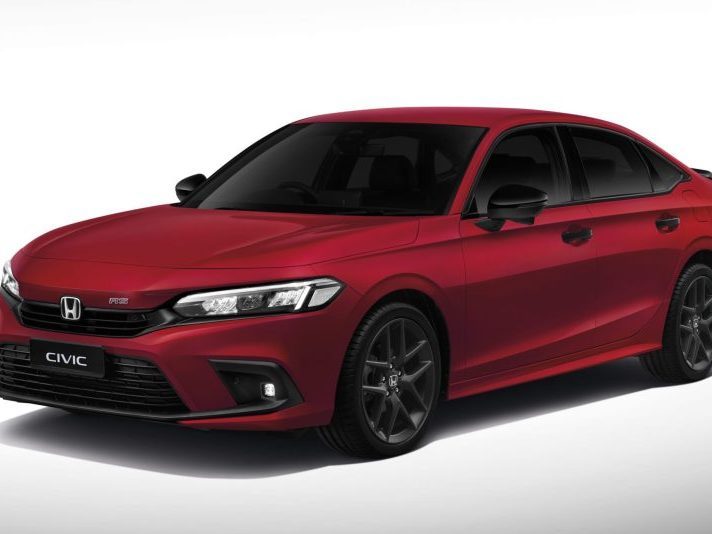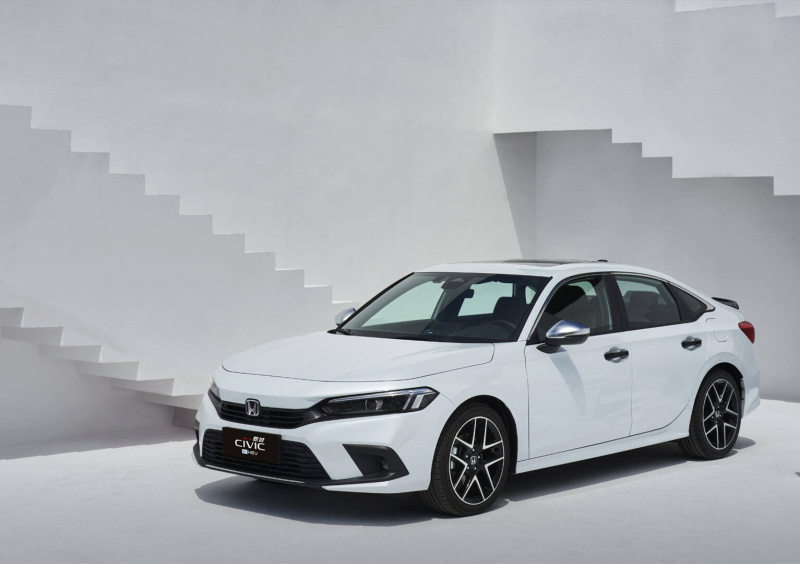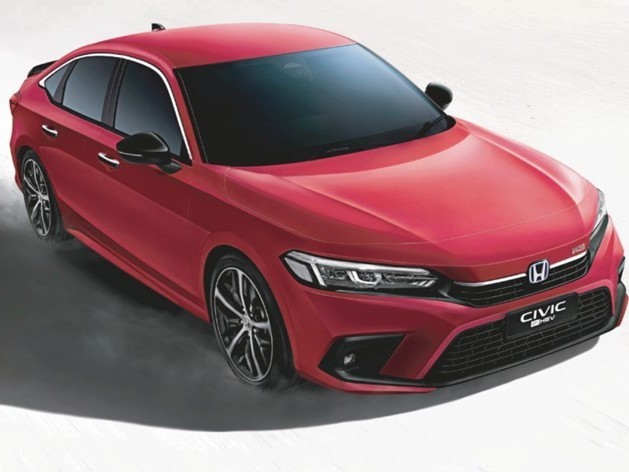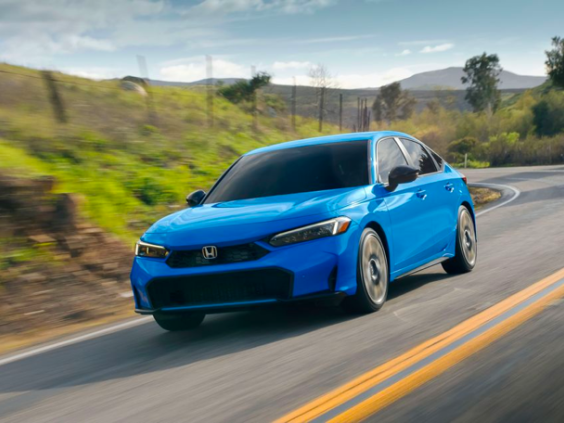Q
How fast can a Honda Civic 2021 go?
The top speed of the 2021 Honda Civic varies by specific trim and powertrain setup. Versions equipped with the 1.5-liter turbocharged engine (like the common 1.5T VTEC models) typically have an electronic speed limiter set around 210 to 220 km/h, though actual maximum speed might be slightly higher – but for safety reasons, it's not advisable to test that. This engine cranks out about 173 horsepower, paired with either a CVT or 6-speed manual transmission, delivering smooth acceleration and good fuel economy. It’s worth noting that top speed performance is also affected by road conditions, vehicle load, and maintenance status; daily driving should prioritize adhering to speed limits. Among its class, the Civic is known for balanced performance and modification potential, but tweaking the engine for more power or removing the speed limiter could void warranties and increase risks, so sticking to traffic laws is recommended. Additionally, regularly checking tire pressure, brake systems, and coolant is crucial for maintaining vehicle performance, and when driving at high speeds, pay attention to body stability and wind noise control.
Special Disclaimer: This content is published by users and does not represent the views or position of PCauto.
Related Q&A
Q
Does the 2021 Honda Civic LX have VTEC?
The 2021 Honda Civic LX is powered by a 1.8-liter SOHC i-VTEC naturally aspirated engine. Now, this engine does feature Honda's iconic VTEC technology, but it's important to note that this is the economy-focused i-VTEC system, not the high-performance DOHC VTEC found in sportier models. i-VTEC works by intelligently adjusting valve timing and lift to optimize fuel efficiency—keeping things smooth and efficient at low revs, while delivering more pep when you push it to higher RPMs. This 1.8-liter mill cranks out 104kW of max power and 174Nm of peak torque, paired with a CVT transmission. The whole setup is tuned more for everyday comfort than anything else. VTEC has come a long way since its 1989 debut, and i-VTEC stands out as that classic balance of performance and fuel economy. Even though the LX isn't a sporty trim, this tech still gives it snappier response than your average engine. For shoppers who prioritize reliability and running costs, this powertrain checks the boxes with easy maintenance and solid fuel efficiency—more than enough for daily city driving.
Q
What engine is in a Honda Civic 2021?
The 2021 Honda Civic offers a range of engine options depending on the market. The most common is the 1.5-liter turbocharged four-cylinder, churning out around 180 horsepower and 240 Nm of peak torque. It pairs with either a CVT automatic or a 6-speed manual transmission. This engine is known for its solid fuel efficiency and smooth power delivery, making it perfect for everyday driving. In some markets, there's also a 2.0-liter naturally aspirated four-cylinder as the base option, putting out about 158 horsepower. It's a bit less punchy but cheaper to maintain. Under the hood, Honda's signature VTEC variable valve timing and lift system ensures good low-end fuel economy without sacrificing high-rev power. The Civic's chassis is tuned on the sporty side too, so it handles really nicely. A quick heads-up though: the turbo engine needs the specified viscosity oil as per the manufacturer's recommendation and regular carbon cleaning to keep it reliable long-term. The naturally aspirated one, on the other hand, is more flexible with fuel quality and easier to service.
Q
What are the 2021 Civic trim levels?
The 2021 Honda Civic is available locally in three main trim levels: 1.8S, 1.5TC, and 1.5TC-Premium. The entry-level 1.8S comes with a 1.8-liter naturally aspirated engine, packing basics like 16-inch wheels, LED daytime running lights, and a 7-inch touchscreen. Stepping up to the mid-range 1.5TC gets you a 1.5-liter turbocharged engine, along with upgraded 17-inch wheels, LED headlight assemblies, dual-zone automatic climate control, and Honda SENSING driver assistance system. The top-spec 1.5TC-Premium adds luxury touches such as leather seats, power-adjustable driver's seat, and side blind spot monitoring. It's worth noting that the turbocharged versions not only deliver more punch but also come standard with Honda's advanced active safety tech, including adaptive cruise control and lane-keeping assist. As a popular pick in the compact sedan segment, the Civic's turbo engine strikes a solid balance between fuel efficiency and performance— a big reason why this lineup has stayed in demand for so long. Buyers can pick the trim that fits their budget and needs best.
Q
How many seats does the 2021 Civic have?
The 2021 Honda Civic models available locally typically come with a 5-seat configuration, featuring two rows of seating. The front row has two individual seats, while the rear is a three-person bench, which is more than enough for daily family or friend outings. This car is known for its generous rear legroom—even taller passengers can ride comfortably. The trunk volume is around 519 liters, which stands out among its peers. It's worth noting that the Civic's rear seats fold down in a 60:40 split, further expanding cargo space, making it really handy for hauling longer items. The model continues Honda's MM philosophy (Man Maximum Machine Minimum), which maximizes passenger space within a compact body size—one reason the Civic lineup has stayed popular over the years. If you're eyeing the higher-performance Type R version, it keeps a similar seating layout but swaps in more supportive sport seats to boost the driving experience. For buyers who often need to carry passengers, the Civic's space really outperforms many competitors in its class, and that's a big part of why it's been a long-term bestseller.
Q
What is the size on a 2021 Honda Civic?
The 2021 Honda Civic has a body size of 4658mm in length, 1799mm in width, 1416mm in height, and a wheelbase of 2700mm. This size design provides decent interior space and driving stability, making it suitable for city driving and long trips. The trunk volume is approximately 428 liters, which can meet daily storage needs. As a compact sedan, the Civic's size is above average in its class, ensuring both flexibility and practicality. In addition, its low center of gravity design helps improve handling, and the streamlined body also optimizes the drag coefficient, which is beneficial to fuel economy to a certain extent. If you have higher space requirements, you can consider other models from the same brand, but the Civic is still very competitive in terms of overall performance and cost-effectiveness.
Q
How much horsepower does a 2021 Honda Civic Sport hatchback have?
The 2021 Honda Civic Sport Hatchback is powered by a 1.5-liter turbocharged four-cylinder engine that churns out 180 horsepower and 240 Nm of peak torque. It comes paired with either a CVT automatic or a 6-speed manual transmission, depending on market specifications. This engine features Honda's VTEC technology, striking a balance between power delivery and fuel efficiency. It offers plenty of low-end torque for city driving and enough power reserve for highway overtakes when you need it. The Civic Sport gets sport-tuned suspension and a lightweight body design, resulting in nimble handling that'll appeal to drivers who enjoy a fun-to-drive experience. In its class, the Civic's power figures sit above the middle of the pack, marking a noticeable improvement over the naturally aspirated versions. Turbocharging has now become the go-to choice for small-displacement engines, delivering stronger performance while keeping fuel consumption in check. It's more than enough for daily use and won't leave you disappointed when you feel like pushing it a bit harder occasionally. This powertrain has stood the test of time in the market, boasting reliable performance and relatively reasonable maintenance costs.
Q
How much is the 2021 Honda Civic?
The 2021 Honda Civic's local prices vary depending on the trim and configuration. The base 1.8S model sells for around RM110,000 to RM120,000, while the sporty RS trim is closer to RM130,000. Actual prices might fluctuate a bit with dealer discounts or optional extras. This Civic keeps the lineup's sporty design language, packing either a 1.8L naturally aspirated engine or a 1.5L turbo, balancing fuel efficiency and performance. The interior has a practical layout with tech like a 7-inch touchscreen. In its class, the Civic stands out for reliability, reasonable maintenance costs, and top-notch resale value. If you're looking at used ones, a 2021 model typically goes for 20-30% less, depending on condition and mileage. When buying, besides price, check if the latest model year is out and what the dealer offers in terms of warranty and free service sessions—those things really affect your overall ownership costs.
Q
What engine is in a 2021 Honda Civic?
The 2021 Honda Civic offers a range of engine options depending on the market. The version commonly seen locally is powered by a 1.5-liter turbocharged four-cylinder engine (code-named L15B7), delivering around 173 horsepower and 220 Nm of peak torque. It's mated to either a CVT automatic or a 6-speed manual transmission. This engine is known for its fuel efficiency and smooth power delivery, featuring Honda's VTEC variable valve timing technology. Additionally, some markets get a 2.0-liter naturally aspirated four-cylinder (code-named K20C2), though that's pretty rare to spot around here. What's cool about Honda's turbo tech is how the small-displacement design achieves efficient combustion—you get plenty of low-end torque for daily driving, and maintenance costs stay reasonable too. These small turbo engines have become the go-to choice for family cars lately, especially perfect for city driving with all the stop-and-go. Just stick to regular synthetic oil changes and keep up with scheduled maintenance, and it'll keep performing reliably.
Q
How much horsepower does a 2021 Honda Civic Type R have?
The 2021 Honda Civic Type R is powered by a 2.0-liter turbocharged four-cylinder engine, cranking out 306 horsepower and 400 Nm of peak torque. Mated to a 6-speed manual gearbox, its front-wheel-drive setup delivers outstanding handling for this high-performance hatchback. True to the Type R lineage, it’s got that track-ready DNA—think a limited-slip differential and adaptive dampers that tweak suspension stiffness based on driving modes, balancing daily comfort with hard-core track action. The engine features VTEC tech, really coming alive at high revs with a redline hitting 7,000 rpm and a seriously passionate sound. Now, you might worry about torque steer with a front-driver packing this much punch, but Honda’s dialed in the suspension and electronic aids just right to keep it in check, letting drivers focus on the fun. And for the mod crowd? This engine’s got potential—plenty of enthusiasts are squeezing extra ponies out with just a simple ECU tune.
Q
What is the base model of the 2021 Honda Civic?
The base model of the 2021 Honda Civic is the 1.5L S trim, powered by a 1.5-liter four-cylinder turbocharged engine that cranks out 173 horsepower, paired with a CVT automatic transmission. Standard features include LED daytime running lights, a 7-inch infotainment touchscreen, dual-zone automatic climate control, and the Honda Sensing safety suite (which includes collision mitigation braking, lane keeping assist, and more). Even though it's positioned as an affordable entry-level option, this trim still keeps the Civic's signature sporty chassis tuning and practical interior space. It's worth pointing out that key rivals like the Toyota Corolla typically stick with naturally aspirated engines in their base models, so the Civic's entire series turbocharged setup gives it a leg up in performance. If your budget allows, higher trims add nice-to-haves like leather seats and a power sunroof, but the 1.5L S already covers all the bases for daily driving—especially for value-focused young buyers. It also holds its value pretty well on the used car market, with maintenance costs on par with other Japanese models in its class. Plus, it runs just fine on 92-octane gas, so long-term ownership costs stay manageable.
Latest Q&A
Q
How many miles can a 2019 Yaris last?
The 2019 Toyota Yaris can typically hit 200,000 to 300,000 kilometers or more with regular maintenance and normal driving, its durability mostly hinging on consistent upkeep and driving habits. Under the hood, the 1.5-liter engine is a proven workhorse, paired with either a CVT or 5-speed manual transmission—this powertrain is all about reliability. Stick to scheduled oil changes, transmission fluid swaps, and coolant replacements, plus keep an eye on the brakes and suspension, and you’ll seriously extend its lifespan. Heads up though, tropical climates can be tough on rubber parts and batteries. It’s smart to check hoses and belts every couple of years and stay on top of AC system maintenance to prevent condenser corrosion. If you’re buying used, run a computer diagnostic to check engine health and inspect the undercarriage for rust. These small cars hold up well even past 150,000 km if the service records are solid. In its class, regular timing chain replacements and fuel system cleanings also go a long way in preventing common high-mileage issues. And don’t sleep on the factory service manual—it’s your best guide to keeping this Yaris running strong.
Q
How much is a 2019 Toyota Yaris worth?
Used 2019 Toyota Yaris models typically range from 50,000 to 70,000 Malaysian Ringgit, depending on factors like condition, mileage, trim level, and service history. The base 1.5E variant sits at the lower end of that spectrum, while the higher-spec 1.5G or sporty trims can push closer to the top. This car has always been a hit thanks to its reliability and fuel efficiency, making it perfect for city commuting. Before buying, I’d recommend checking for a complete service record and paying extra attention to the transmission and engine condition. In its class, it edges out the Honda Jazz in terms of sound insulation but falls a bit short on interior space. Units with under 40,000 km and remaining factory warranty tend to hold their value better. Right now, there’s plenty of supply in the used car market, so take your time to compare offers from different dealerships or private sellers. Also, keep in mind that some 2019 models might still be within the original factory warranty period – definitely a nice bonus for long-term ownership.
Q
Is the Toyota Yaris 2019 a good car?
The 2019 Toyota Yaris is a solid small car option, standing out for its reliability, fuel efficiency, and everyday practicality. Under the hood, you'll find a 1.5-liter naturally aspirated engine that delivers smooth power—perfect for city commuting. It’s also pretty thrifty on gas, which should save you some cash at the pump over time. The interior is straightforward; sure, there’s a lot of hard plastic, but the build quality feels solid, right in line with what you’d expect for the price. Safety-wise, it comes with basics like ABS, EBD, and VSC, and higher trims might throw in some extra safety goodies. Space-wise, the front seats have enough room, but the back seat and trunk can feel a bit tight if you’re hauling a family around. Resale value is above average for the class, maintenance costs are reasonable, and parts are easy to come by. The small car segment’s pretty competitive—you’ve got options like the Honda Jazz and Mazda 2 in the same price range—but the Yaris has the edge with Toyota’s reputation and consistent quality. If your main thing is zipping around the city, don’t need blistering power, and just want something reliable and low-hassle, the 2019 Yaris is a solid pick. Definitely take it for a test drive first to see if the driving feel and space work for you, and check out the differences between model years and trims while you’re at it.
Q
What was the fuel economy of Alza 2018?
The 2018 Alza delivers average fuel economy. Its 1.5-liter naturally aspirated engine paired with a 4-speed automatic transmission returns a combined fuel consumption of approximately 6.5 to 7.0 liters per 100 kilometers. Actual figures may vary depending on driving habits, road conditions, and vehicle maintenance. As a family MPV, its fuel efficiency is par for the course in its class, making it suitable for daily commuting and family use.
If owners want to improve fuel efficiency, they can maintain a steady driving speed, avoid sudden acceleration and hard braking, and regularly replace engine oil and air filters. These simple tips not only help save fuel but also extend engine life.
Additionally, with advancements in automotive technology, hybrid and fully electric models have seen significant improvements in fuel economy in recent years. If fuel consumption is a top priority, these new-technology vehicles are worth considering. However, as an affordable and practical option, the Alza still meets the daily needs of most families.
Q
What are the dimensions of the Alza 2018?
The 2018 Alza measures 4270mm in length, 1695mm in width, and 1600mm in height, with a wheelbase of 2750mm. As a compact MPV, these dimensions offer nimble handling for city driving while ensuring practical interior space, making it ideal for family use. It has a ground clearance of 160mm, which can handle regular road conditions, and a 42-liter fuel tank that meets the needs of daily commuting and short to medium-distance trips. For some extra context, the 2018 Alza uses a front-engine, front-wheel-drive layout. This design helps maximize interior space, especially when it comes to arranging the second and third-row seats. While the third row is more suited for kids or short rides, the overall space performance is still competitive in its class. Additionally, it weighs around 1.2 tons and is paired with a 1.5-liter naturally aspirated engine, striking a good balance between fuel efficiency and power output – perfect for consumers who value practicality and economy.
View MoreRelated News

Honda Civic Interior Revealed: A Comprehensive Analysis of Civic’s Interior Charm
Kevin WongJul 10, 2025

Honda Civic Price Revealed: The Most Detailed Buying Guide!
AshleyApr 8, 2025

Whether it's about appearance or handling, why do young people all like Honda Civic?
WilliamSep 24, 2024

2022 Honda Civic: Hybrid car with the fastest acceleration, lowest fuel consumption, who says eco-friendly cannot be fast
JohnSep 3, 2024

2025 Honda Civic debuts, minor changes in appearance, has 1.5 Turbo model been discontinued?
LienMay 22, 2024
View More













 Cars
Cars




Pros
Cons